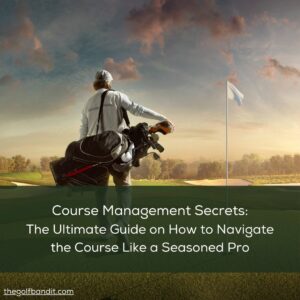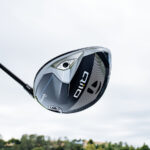Sometimes, the biggest difference between the professionals and the amateurs isn’t the skill level. It’s the approach to the game. If you have not watched professional golf recently, I suggest you do so. You’ll likely notice some of these strategies that help professionals succeed on the course. Your athletic ability may not be the same as that of the greatest players in the game, but you are very likely doing some things that will hurt your scoring capability. Change that today!
Professionals Have a Plan – Amateurs Hit and Hope
Professional golfers are meticulous when it comes to their golf course management. Every shot, every hole, every putt is planned and calculated.
As an amateur player, how many times have you stood over a ball and just hoped it would end up somewhere that didn’t involve sand or water?
Probably more times than you should have. Having a plan for every hole ensures that you balance that risk and reward and attempt to shoot low scores.
Professionals Track Everything – Amateurs Know Their Score
Did you know that Matt Fitzpatrick has a log of every single shot that he’s taken in a professional event. This takes some time, attention to detail and a bit of love for stats and numbers. You don’t have to go as far as Fitzpatrick but it can help to start to track some of your rounds.
Pay close attention to fairways hit, greens hit, and number of putts. Track not just where you miss but how much you missed by and why. (slice, hook, chunk, blade, etc.)
If you can find a great strokes gained app, you’ll also understand exactly where your game needs improvement.
Professionals Work On Mental Toughness – Amateurs Look for Excuses
Did the dog bark in your backswing? Was your friend fishing for something in his pocket while you were trying to putt? Did you shoot 10 strokes higher just because there was a $1.00 bet on the hole?
These are all common mistakes made by amateur players.
Professionals practice mental toughness. They work on how to thrive under pressure and have techniques and routines built into their day to help them get better. Mental conditioning also includes proper visualization.
If you visualize the ball going into the water, it may very well end up there!
Professionals Work On Their Fitness – Amateurs May Not Understand The Importance
It’s hard to say that every single professional on the PGA Tour is in good physical conditions.
However we can see that the percentage of golfers who are putting time and effor into their physical fitness has grown significantly in the last 15 years.
It’s easier to hit a golf ball far if you are in good physical shape.
Hitting the ball further helps you get closer to the hole and make more birdie putts. TO get better at golf, work on things like core strength and leg strength. Being able to utilize the ground forces as you hit the ball makes a big difference in power.
Professionals Know Dozens of Short Game Shots – Amateurs Know 1 or 2
Start to look at your golf wedges as tools.
You should be able to hit each of your wedges low, mid-range, and high. You should be able to hit them with spin and also be able to let the ball roll out if you want. Amateurs try the same sand wedge or pitching wedge shot from various locations.
This isn’t smart.
Learn to read a lie, pick a club, and execute the shot. The next time you work on your short game, take all of your wedges out of the bag and hit them from different lies and angles. Vary the height of the shots.
Professionals Are Always Learning On the Greens – Amateurs Read One Line
Golf professionals get up to a green and walk all the way to the hole and even back around the other side of the hole. They may not even go to their golf ball until they have completed this.
Why?
Professionals are continually learning about the course they are playing and trying to gather any details they can. If they aren’t up first, they’ll watch what other golfers are doing and how the ball is changing near the hole.
Pro golfers expect to make these putts, and they put in the time to ensure that happens.
You can do this too!
Professionals Structure Their Practice – Amateurs Hit A Bucket of Balls
Professionals have structured practice sessions. They show up to the practice with a plan in place and they stick to the plan. The plan may be to work on a weak point in their game, to gain more confidence or to work on timing and tempo.
The next time you go out to practice try to put together a plan and set some goals before you go out. Simply swinging away is a mistake and you likely won’t improve your abilities anytime soon.
Professionals Care About Nutrition and Hydration on the Course – Amateurs look for Hot Dogs and Sports Drinks
There’s a reason PGA Tour professionals don’t stop for a hot dog at the turn. They have strict dietary and hydration procedures they follow so that their body performs better on the course.
With the right foot and drink in your system, your ability to maintain energy levels and concentration throughout the rough is greatly increased. Try to incorporate plenty of water and some protein so that you feel good coming down the 18th fairway.
Professional Golfers Play To Their Strengths – Amateurs Try
The Hero Shot
Professional golfers know where their weaknesses are. Sometimes, it’s as simple as a tendency to hit the ball left off the tee under pressure. However, they are aware of these strengths and weaknesses, and they play to them in the course.
Amateurs love the 215-yard shot over the water to go for a green in two.
This just isn’t the time for this shot, UNLESS, it’s one of your strenghts. If you are great at this shot and can pull it off 7/10 times, go for it. Professionals sometimes play safer and save a par or even a bogey so that they don’t end up with doubles and triiples.
Professionals Can Adapt – Amateurs Complain
Finally, professionals can adapt to various conditions on the golf course. This can be anything from wet fairways, bumpy greens, or slow play. They know how to stay focused on their game and keep their head in it.
Amateurs find excuses.
They start to look at things like wind or rain and say they’re the reason for their high scores. A professional can adapt and make the necessary changes in their game to still shoot low scores. Stop making excuses and instead make solutions and see how they impact your game.
Final Thoughts
At this point, you should feel more confident in your ability to match what the pros are doing. You won’t have the same swing path or swing speed, and your results will likely not be the same. However, when you start to think and act a little more like a pro, you may discover how they got as good as they did. Start small and work your way down to a single-digit player; it may happen faster than you think.




